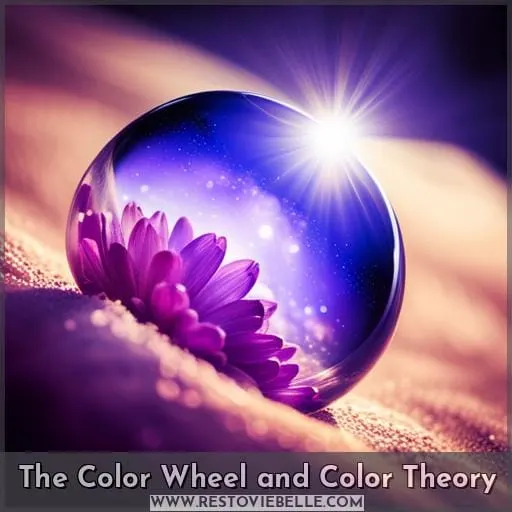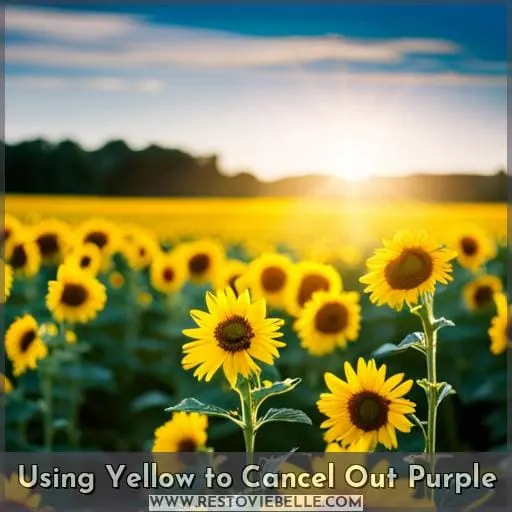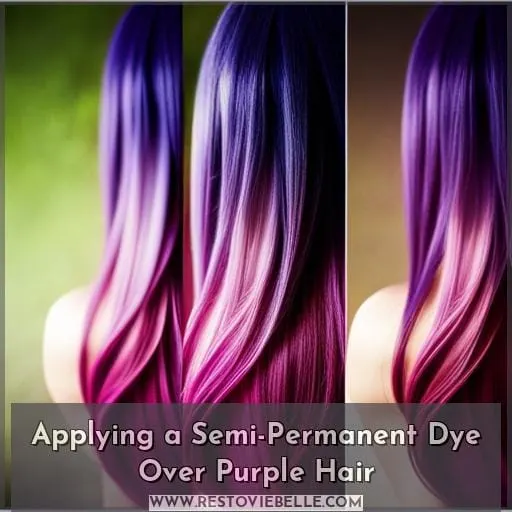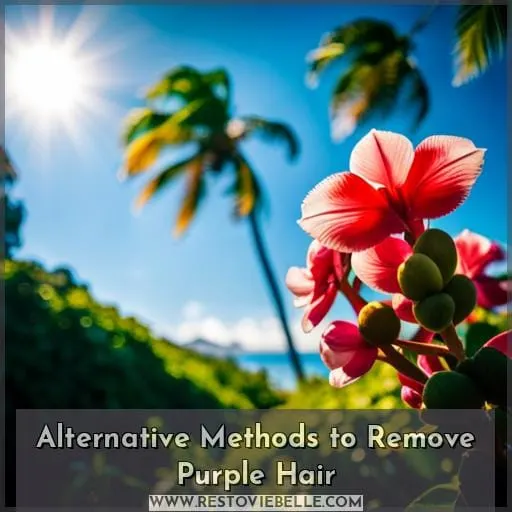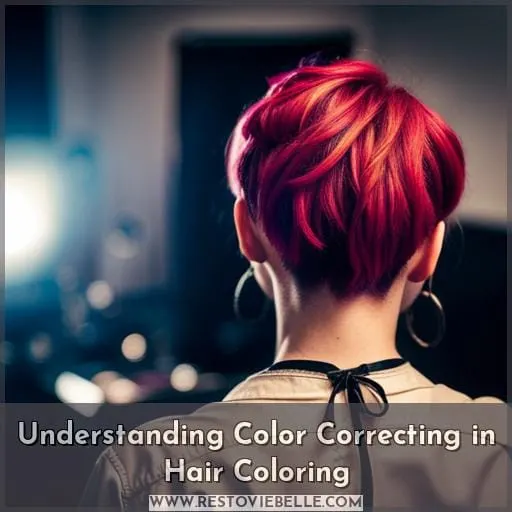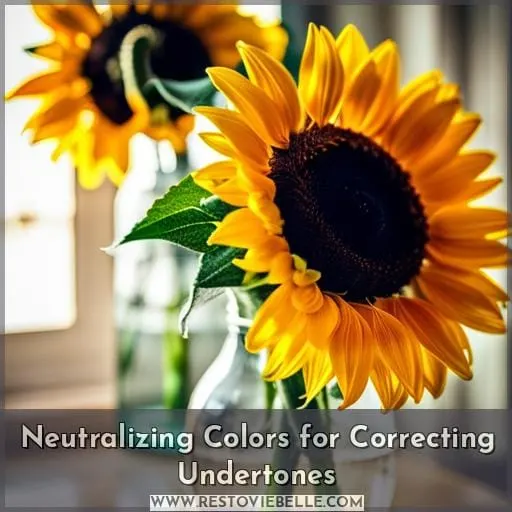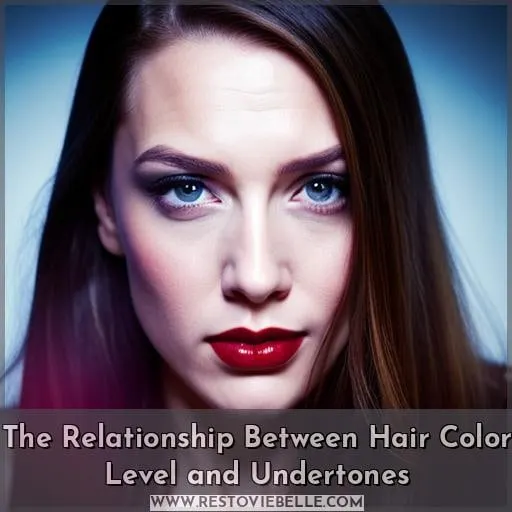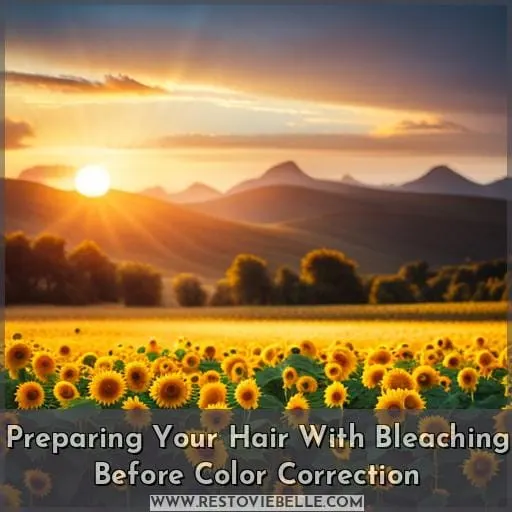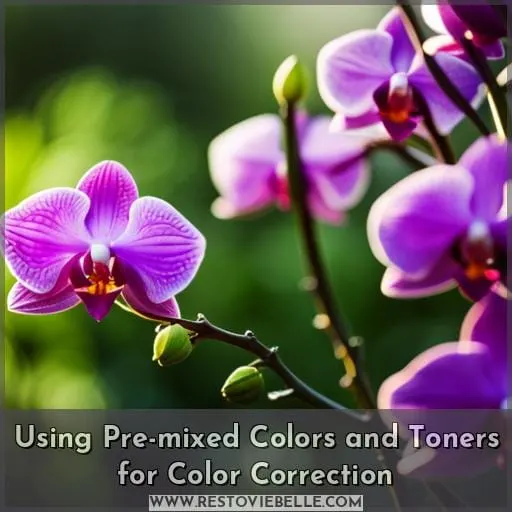This site is supported by our readers. We may earn a commission, at no cost to you, if you purchase through links.
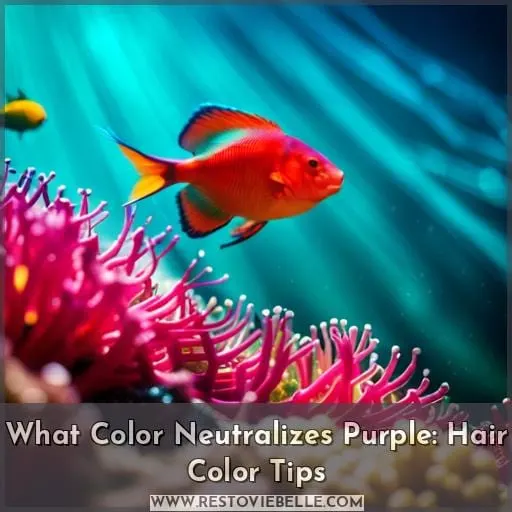 Are you looking for a way to neutralize your purple hair color? You’ve come to the right place! In this article, we’ll discuss how yellow can help cancel out purple and provide alternative methods if toning isn’t an option.
Are you looking for a way to neutralize your purple hair color? You’ve come to the right place! In this article, we’ll discuss how yellow can help cancel out purple and provide alternative methods if toning isn’t an option.
We’ll also explore color correcting in hair coloring and which colors are best for counteracting unwanted undertones. Finally, we’ll cover prepping your hair with bleaching before color correction as well as using premixed colors and toners to achieve desired results.
By the end of this article, you should have all the tools you need to be able to effectively tackle what color cancels out purple!
Table Of Contents
- Key Takeaways
- The Color Wheel and Color Theory
- Using Yellow to Cancel Out Purple
- Applying a Semi-Permanent Dye Over Purple Hair
- Alternative Methods to Remove Purple Hair
- When to Seek Professional Help
- Understanding Color Correcting in Hair Coloring
- Neutralizing Colors for Correcting Undertones
- The Relationship Between Hair Color Level and Undertones
- Preparing Your Hair With Bleaching Before Color Correction
- Using Pre-mixed Colors and Toners for Color Correction
- Conclusion
Key Takeaways
- Yellow or orange toner can be used to neutralize purple hair tones.
- Complementary colors on the color wheel can cancel out unwanted hues.
- Considering the undertones and dye type is crucial before using toner.
- Understanding the basics of the color wheel is essential for effective color correction.
The Color Wheel and Color Theory
You can use the color wheel and color theory to achieve beautiful results when it comes to canceling out unwanted purple tones in your hair or complexion. Color mixing, the basics of a color wheel, makeup techniques, and hair dye tips are all important factors for success.
With these tools, you can learn how to apply different methods of color correction. One way to cancel out unpleasant purple hues while still maintaining beauty trends with creative flair is by using complementary colors on opposite sides of the wheel.
However, it’s important to consider undertones before using orange as an effective solution for darker purples.
Semi-permanent dyes can also help reduce undesirable shades, but it’s crucial to take precautions beforehand. If necessary, consult a professional for guidance. By following these steps together with natural remedies such as bleaching or stripping colored deposits from your locks, you’ll have no trouble finding what works best for you.
Using Yellow to Cancel Out Purple
Are you looking for a way to cancel out the purple tones in your hair? Toning is an effective solution that uses yellow to neutralize purple. By understanding how the color wheel works and learning about toner products, you can easily achieve vibrant and healthy locks without any unwanted hues.
Toning Your Hair
To tone your hair and bring out its best hue, start by understanding the power of complementary colors from the color wheel. For example, if you have purple tones in your locks that you want to get rid of, yellow can be used as a secret weapon.
Here are some tips for toning:
- Understand hair pigments and purple undertones.
- Use toner with either yellow or orange shades.
- Choose between semi-permanent dye or professional coloring services.
- Experiment with bleaching techniques to lighten darker hues.
- Consult a colorist for advice on making sure it’s done right.
With knowledge on the components involved when using complementary colors with each other, such as those found in the Color Wheel, anyone can successfully tone their tresses without fear of overdoing it!
Considerations Before Using Toner
Before using toner to reduce purple tones in your hair, consider the undertones and type of dye you’re using. Toner precautions involve a thorough understanding of color wheel principles. It’s important to recognize violet-based pigments and take note of past mistakes.
Application requires even application from root to tip for consistent results. There are different types of toners available, such as yellow or orange toners for mild or dark purple, respectively.
The benefits of using toner range from correcting errors without causing damage to achieving desired shades with fewer steps compared to techniques like bleaching. Keep in mind that results may vary depending on the amount of toner used and your natural hair shade.
Applying a Semi-Permanent Dye Over Purple Hair
Try transitioning from a bold purple hue to brown hair with semi-permanent dye, and use yellow toner to reduce any remaining unwanted tones. Semi-permanent application is an excellent option for those looking for temporary color options without damaging their hair or having it fade quickly.
Here are some tips:
- Choose a semi-permanent dye that matches your desired shade of brown.
- Apply the product evenly throughout your entire head, making sure not to leave out any sections of purple still lingering in the hair strands.
To ensure optimal fading and color longevity, wait around 2 weeks before shampooing and conditioning again after each application process on dyed locks so you can achieve longer-lasting results.
If there are still subtle hints of purple left behind even after using yellow toner, then consider other vibrant alternatives such as bleaching or alternate shades like reds. These could act as complimentary colors when applied over faded purples on the color wheel chart/hair color correction palette.
Alternative Methods to Remove Purple Hair
Are you looking for alternatives to remove purple hair? Bleaching, color stripping, hot oil treatments, clarifying shampoos, and vitamin C treatment are some of the methods that can be used. These techniques offer solutions for all kinds of purple hair problems, from restoring your natural shade to achieving a brilliant blonde hue.
Bleaching
Bleaching is an effective way to lighten dark purple hair and reduce unwanted tones. It’s important to take precautions when bleaching, such as conducting a strand test beforehand and using protective gloves throughout the process.
There are several options for lightening the hair, including bleach kits or professional services at salons. After bleaching, toners can help cancel out violet-based pigments to achieve the desired color results.
You can refer to a personal color wheel chart or seek guidance from professionals.
DIY removal of purple hues may be possible, but it’s always best to consult with experts to ensure the safety of your hair when removing permanent dye colors.
Color Stripping
If bleaching doesn’t work for you, give color stripping a whirl! This alternative method works to remove unwanted purple tones from your hair and restore it back to its original hue in no time.
Color stripping techniques can easily be done at home as a DIY color correction process or with professional hair help. It involves the use of special shampoos, conditioners, and products designed specifically for removing permanent dyes while preserving natural oils in the scalp.
For maximum results, try pairing these products with yellow-toned toners or even using color-correcting concealer if necessary.
Remember that understanding how colors interact is key when attempting any kind of DIY project.
Hot Oil Treatments
Hot oil treatments can be an effective way to reduce the purple tones in your hair. They nourish and soothe the scalp, strengthen roots, help retain moisture, and add a layer of protection. To start, warm up some natural oils like coconut or almond for application. Then, massage the oil into the scalp with gentle circular motions.
Cover your head with a cap or wrap it in a towel. Allow time for absorption, typically 30-60 minutes. After that, rinse out the oil thoroughly and shampoo and condition your hair as usual. This method is great not only for neutralizing purple color but also for improving the overall health of your hair.
Hot oil treatments are an easy alternative when trying to remove unwanted tones from dyed hair without harsh chemicals.
Clarifying Shampoos
Clarifying shampoos can be an effective way to remove excess buildup of purple hair dye and restore natural tones. When looking for a clarifying shampoo, check the label for ingredients like sulfates or detergents that will help strip away any product build-up.
Use it weekly or biweekly, depending on how often you color your hair. However, keep in mind that using it too frequently may dry out your locks.
With these tips and proper product recommendations in hand, you’ll soon have beautiful, healthy tresses free from unwanted purple hues!
Vitamin C Treatment
For those looking to reduce unwanted purple tones in their hair, a vitamin C treatment is an effective and gentle option. Vitamin C processing helps balance out the pigments in your hair by neutralizing the color molecules of purple dye.
The results are usually visible within minutes of application. However, some may require multiple treatments depending on the severity of the issues.
There are many products that can be used for this process. You can use shampoos and conditioners with added vitamin C, or you can make your own solution at home using ingredients like lemon juice and baking soda mixed together with water.
Regardless of how you choose to use it, caution should always be taken when dealing with any type of chemical reaction. There could potentially be adverse reactions due to overprocessing or skin sensitivity issues from harsh ingredients found in certain products.
With proper guidance and knowledge about the vitamin C process, anyone who wants to remove unwanted shades can do so without damaging their mane!
When to Seek Professional Help
If you’re unsure of how to proceed with color correction, it’s best to consult a professional for help. A hair colorist can provide expert advice and guide you in the right direction. They have extensive knowledge of the hair color wheel and techniques used for correcting purple tones, making them well-equipped to help fix any mistakes made while dyeing or toning your hair.
Professional consultation is key when attempting complex processes such as changing from dark purple to brown hair or transitioning between colors without damaging your locks. Salon expertise ensures that the desired results are achieved quickly while avoiding potential damage caused by incorrect methods or products like bleach and harsh dyes that contain chemicals, which can be dangerous if mishandled.
Color correction requires careful consideration of underlying undertones, something only an experienced professional can effectively manage.
Understanding Color Correcting in Hair Coloring
When it comes to hair color, understanding how color correcting works is essential for achieving the desired results. Color wheel basics help you identify which colors cancel out purple undertones and avoid making a common mistake of applying the wrong shade.
Hair dye options like semi-permanent dyes or toners can be used to remove unwanted tones in bleached or dyed hair. Use a yellow toner for mild purple tones and orange for dark ones. Apply the toner from root to tip and always follow up with conditioning.
There are other methods available too, such as bleaching, color stripping, and natural remedies. However, caution is advised when attempting DIY corrections. It’s best to seek professional advice for the best results.
Professionals understand your specific needs and have access to more advanced techniques that could provide a better outcome than at-home solutions alone.
With knowledge of correct coloring principles, you won’t go far wrong. Take the time now to explore what works best for your individual situation!
Neutralizing Colors for Correcting Undertones
To effectively neutralize purple undertones, use complementary colors such as yellow or orange toners for mild tones. For deeper hues, stronger pigments like red, blue, and green can be used. The color wheel is a helpful tool in understanding which colors will cancel out violet-based pigments.
For a professional look, it’s best to seek the help of a makeup artist or hairdresser who is familiar with color theory.
When choosing products, make sure they are suitable for your skin type. Using the wrong product on sensitive areas of skin can cause further damage. Color depositing conditioners can also be used after bleaching hair. These conditioners deposit natural-looking colors that blend with existing shades while neutralizing unwanted tones.
DIY coloring is not recommended unless you have enough experience. However, if done correctly, it can bring desired results without causing too much damage to the hair.
The Relationship Between Hair Color Level and Undertones
Understanding the relationship between hair color level and undertones can help you decide which toner to use for correcting purple hues. Hair color levels are determined by the primary pigments in your hair: red, yellow, and blue.
When analyzing your undertone, it is important to consider whether or not there is a dominant hue of purple present. This will help determine what type of color correction technique should be used. If you have darker colored hair with purple hues, then bleaching may be necessary prior to dye application.
Alternatively, if you have lighter colored hair that only needs slight adjustment, semi-permanent dyes might suffice.
The Color Wheel also plays an essential role when considering complementary colors for cancelling out certain shades.
Preparing Your Hair With Bleaching Before Color Correction
Before attempting hair color correction, consider the importance of pre-treating your locks with a bleaching process to lighten them sufficiently.
- Consult a professional for help if needed.
- Be aware of any purple undertones in the hair before taking on this task.
- Use an at-home kit or pre-mixed colors and toners specifically designed for color correction.
- Understand basic color wheel principles to avoid mistakes when mixing tones and shades together. For example, blue cancels out green while orange neutralizes blue pigments in hair dye.
- Apply toner from roots to tip as part of post-coloring treatment.
Bleaching can be very damaging, so it is important to proceed cautiously – especially if you are trying something new. It is also wise to seek assistance from knowledgeable professionals who can provide recommendations based on specific needs and desired results.
Using Pre-mixed Colors and Toners for Color Correction
You can use pre-mixed colors and toners like a painter using their palette to achieve the shade you desire, creating an artful transformation that’s as easy as pie.
To cancel out purple tones in hair, it’s important to understand color correction techniques. This includes toner application and mixing the right shades of pigment for desired results.
Violet-based pigments require yellow or orange counteraction on the hair color chart, while blue undertones need more orange than yellow for balance.
Color stripping is another option, along with a color depositing conditioner if you want to lighten up your locks without bleaching them first.
For safe DIY attempts at home, always consult a professional who can advise on specific products and techniques best suited for individual needs according to skin tone and hair type before beginning any coloring process.
Conclusion
You’ve come to the end of your journey to understand what color cancels out purple in hair color correction. With the help of the color wheel and color theory, you now know that yellow is the key to reducing purple tones in hair.
Whether you choose to tone your hair with yellow or orange toner, apply a semi-permanent dye, bleach it, or try a natural remedy, you can now confidently color correct your hair.
If you feel overwhelmed or uncertain, it’s always best to seek professional help. With the right understanding of color correcting and neutralizing colors, you can correct the underlying tones in your hair and create the look you desire.
